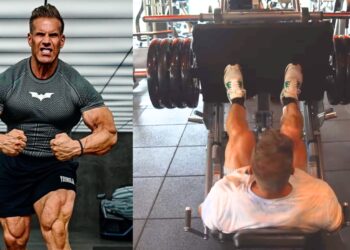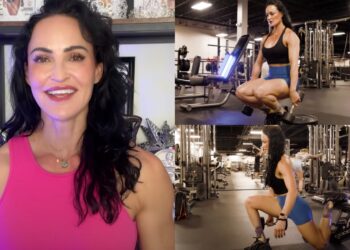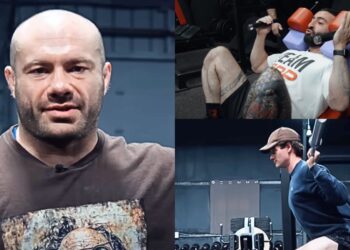The curtsy lunge is a functional exercise that can help you build core stabilization, muscle mass, strength, coordination, and balance. Only a few other exercises can match the benefits of the curtsy lunge. It is a lunge with a twist—literally!
The curtsy lunge got its name from the traditional gendered gesture of greeting, in which a girl or woman bends her knees while bowing her head. The fitness experts saw this compound movement and ran with it. It’s probably also the reason why you mostly see women perform this exercise.
The curtsy lunge, also known as the drop lunge, has a learning curve and can intimate newbies. However, we’ve got you covered. This article sheds light on the muscles worked, benefits, correct techniques, common mistakes, and variations of the curtsy lunge.
Muscles Worked: Curtsy Lunge
The curtsy lunge targets the following muscle groups:
Quadriceps
Quads are the primary target muscles of the curtsy lunge. The front of your upper legs is activated when you lunge, lengthening and shortening them as you squat and stand.
Glutes
The curtsy lunge activates all three gluteal muscles—maximus, medius, and minimus. It helps build the shape and size of your butt and strengthens your adductors and abductors. The medius and minimus help pull your legs toward or away from the center of your body.
Level Up Your Fitness: Join our 💪 strong community in Fitness Volt Newsletter. Get daily inspiration, expert-backed workouts, nutrition tips, the latest in strength sports, and the support you need to reach your goals. Subscribe for free!
You’ll feel a burn in the quad of your front leg and the glute of your rear leg while performing the curtsy lunge.
Calves
The soleus and gastrocnemius are in a supporting role in this exercise. Most exercisers will struggle with their rear leg while performing the drop lunge, and you might see their back leg shaking profusely. The rear leg does so to help stabilize and balance your body. Most of this brunt is handled by your calves. On the other hand, the front calf is kicked into action as it helps you maintain an upright torso as you perform a split squat.
How To Perform The Curtsy Lunge
This is how to perform the curtsy lunge using the correct form:
- Stand upright with a shoulder-width stance.
- Place your hands on your hips for stability or fold them in front of your chest—whatever is more comfortable.
- Shift your weight onto the right foot, take a step back with your left leg, and across to the right behind the right leg.
- Bend at your knees and lower yourself until your right thigh is parallel to the floor and your left knee is a few inches away from the floor.
- Keep your torso upright throughout the motion.
- Return to the starting position by pushing through your rear leg.
- Repeat on the other side.
- Alternate between legs for recommended reps.
Tips to get the best bang for your buck:
- Take a big step back to ensure your front knee does not extend over your toes at the bottom as it can put unnecessary strain on your knees.
- While at the bottom, drive the heel of your front leg into the floor and lift yourself to return to the starting position using your front leg for greater gluteal engagement.
- On the other hand, push off from the bottom of the movement using your rear leg to put more emphasis on your quads.
- Keep your core contracted throughout the movement for better stability and balance.
Common Mistakes
Here are the common mistakes people make while performing the curtsy lunge:
1. Taking Too Big a Step Back Across
Many trainers make the mistake of stepping too far across while performing the curtsy lunge. Doing so takes the tension away from your glutes and puts in your knees and core.
Take a large enough step back so that your front knee does not extend over your toes. However, do not step across so wide that this movement turns into a standing Russian twist. Your hips should be square with the rest of your body throughout the exercise.
2. Bending Forward on the Descent
Bending forward can make the curtsy lunge easier as it reduces the tension on your lower body. Keeping your torso upright puts maximum strain on your lower body muscle tissues.
If you are a rookie and cannot maintain balance while performing the curtsy lunge, you could perform a regression variation by holding onto an object for support.
3. Performing Shallow Lunges
The curtsy lunge is very physically demanding as it is a multi-joint exercise. However, most people rush through it by performing shallow lunges.
You are leaving gains on the table by not following a full range of motion. Your rear knee should be a couple of inches off the floor at the bottom.
Benefits of Curtsy Lunge
Adding the curtsy lunge to your exercise arsenal entails the following benefits:
1. Improves Stability, Balance, and Posture
Performing the curtsy lunge requires core engagement, which improves your balance and stability. Plus, curtsy lunges target your gluteus medius, which can aid in improving your posture by stabilizing your hips.
2. Builds Muscle Mass and Strength
The curtsy lunge is a compound movement that can help you achieve hypertrophy. Furthermore, research has shown that lower body resistance training exercises can help boost testosterone levels. Testosterone is the male hormone responsible for building muscle mass. [1]
Although testosterone is the male sex hormone, women too produce this hormone naturally in quantities that aid in toning and strengthening muscles.
3. Boosts Metabolic Rate
Since the curtsy lunge is a compound exercise, it spikes your metabolic rate, which helps burn calories throughout the day, even when you are sedentary.
4. Great Warm-Up and Finisher
The cursty lunge is a great exercise to warm up your lower body before a workout or end a training session with a muscle-ripping pump. Make sure you follow a full range of motion and perform the reps with a slow and controlled motion to make the most of this exercise.
5. Improves Coordination
The many moving pieces of the curtsy lunge can help improve your leg-hand-eye coordination. Since it is a compound movement, its benefits transcend to other functional exercises and your day-to-day activities.
Level Up Your Fitness: Join our 💪 strong community in Fitness Volt Newsletter. Get daily inspiration, expert-backed workouts, nutrition tips, the latest in strength sports, and the support you need to reach your goals. Subscribe for free!
Curtsy Lunge vs. Conventional Lunge
The curtsy lunge is a conventional lunge variation. Here are a few differences between the two:
1. Different Movement Patterns
Although the curtsy and conventional lunge both involve performing a split squat, the movement pattern is the main differentiator between the two.
While the conventional lunge requires you to step forward or back in a straight line, the curtsy lunge involves stepping behind and across your body.
2. Target Muscles
The conventional and cursty lunge both target almost all the same muscles. However, the curtsy lunge takes the pie in this department as it engages the adductors and abductors, which are not recruited in the conventional lunge.
3. Difficulty
Due to its more complex movement pattern, the curtsy lunge is comparatively harder than the conventional lunge. For better muscle fiber recruitment and contraction, beginners should master the conventional lunge before adding the curtsy lunge into their training regimen.
Variations of the Curtsy Lunge
Given below are some curtsy lunge variations and alternatives to add to your lower body training routine:
1. Weighted Curtsy Lunge
The weighted cursty lunge variations involve using added resistance while the movement pattern remains the same. Some of the most common weighted cursty lunge variations include:
a. Kettlebell Curtsy Lunge: In this variation, you could perform a cursty lunge while holding a kettlebell with both hands in front of your chest or grabbing it in one hand on the side that will remain in position.
b. Dumbbell Cursty Lunge: You’ll be holding onto a dumbbell in each hand at your sides in this cursty lunge variation.
c. Barbell Cursty Lunge: The barbell cursty lunge involves performing the drop lunge with a bar placed across your shoulders.
d. Smith Machine Cursty Lunge: It is a stricter variation of the barbell drop lunge and is performed on a Smith machine.
2. Curtsy Lunge with a Side Kick
The curtsy lunge with a side kick is an advanced variation of the drop lunge.
How to perform:
- Stand upright with a shoulder-width stance.
- Place your hands on your hips for stability.
- Shift your weight onto the right foot, take a step back with your left leg, and across to the right behind the right leg.
- Bend at your knees and lower yourself until your right thigh is parallel to the floor and your left knee is a few inches away from the floor.
- Instead of returning to the starting position and placing your feet under your left shoulder, kick your leg diagonally to your left in front of you.
- Return to the lunging position and complete the recommended reps on the same side before switching sides.
3. Jumping Lunge
The jumping lunge is a high-impact advanced lunge variation. However, this exercise is incredibly effective at building lower body explosive strength.
How to perform:
- Get into the starting position by assuming a staggered stance with your right leg in front of the left.
- Bend your arms so that your right forearm is perpendicular to the floor and the left is parallel to the floor.
- Bend your knees and lower into a lunge. You should imagine a spring being put under pressure while lowering into a lunge.
- As soon as you reach the bottom of the motion, explode off the floor by fully extending your knees and hips.
- As you jump into the air, bring your feet quickly together and switch leg and arm positions as you begin to land.
- Immediately lower into a lunge.
- Repeat for recommended reps.
4. Conventional Lunge
The conventional lunge is one of the first exercises you learn when you start training. You could perform this exercise using your bodyweight or switch to a weighted version as you gain more experience.
How to perform:
- Stand upright with a shoulder-width stance.
- Step forward to assume a staggered stance with your right leg in front of the left.
- Bend both knees simultaneously until the back knee is a few inches off the floor and your front thigh is parallel to the floor.
- Drive through the front foot and extend the knee as you stand up fully and return to the starting position.
- Repeat on the other side.
- Alternate between sides for the recommended reps.
5. Step-Up
The step-up is a lunge variation that involves stepping onto an elevated platform. You could perform this exercise using your bodyweight or while holding a dumbbell or kettlebell in each hand.
How to perform:
- Stand upright in front of an elevated platform that is 8-12 inches high.
- Place your right foot on the elevated platform while keeping your left planted on the floor.
- Drive through the front foot and extend the knee to lift the left foot off the floor.
- Slowly return your left foot to the floor.
- Repeat for recommended reps before switching sides.
FAQs
How can I include curtsy lunge in my training routine?
You could perform weighted curtsy lunges in your workout or use it as a warm-up exercise or finisher. Use it as a dynamic stretching move in a warm-up or finisher routine. However, aim for 10-15 reps on each side for hypertrophy.
Are curtsy lunges better than conventional lunges?
It depends on how you define ‘better’. If better means more glute, adductor, and abductor engagement, then yes, the curtsy lunge is better than conventional lunges. However, both exercises deserve a place in your exercise arsenal.
Is the curtsy lunge bad for your knees?
Because of its unique movement pattern, the curtsy lunge can place more stress on your knees than the conventional lunge, especially if you step too far across your body. However, there is no concrete evidence to prove curtsy lunge’s ill effects on the knees.
Wrapping Up
The curtsy lunge is one of the few exercises that simultaneously work on your muscle mass, strength, balance, and coordination. It is a great exercise for people who want to build glute size or improve their adductors and abductors.
This article sheds light on the many benefits of the curtsy lunge, and we hope they are enough to get it a place in your training routine. Try it out, and let us know how it goes. Best of luck!
References
- Kraemer, W., Häkkinen, K., Newton, R. et al. Acute hormonal responses to heavy resistance exercise in younger and older men. Eur J Appl Physiol 77, 206–211 (1998). https://doi.org/10.1007/s004210050323
Interested in measuring your progress? Check out our strength standards for Squat, Russian Twist, Lunge, and more.








